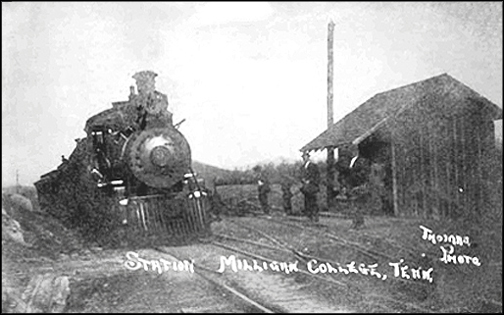On January 25, I wrote about the collapse of White Rock Summit in 1882 that terrified the roughly 750 townspeople living nearby. The event was reported in several newspapers around the country.

My conjecture at that time was that the beautiful White Rock we know today is a small component of a once enormous, impressive rock formation. To the rescue came Ted Thomas, associate professor of humanities, history and German at Milligan College. Dr. Thomas located an entry written by a student, James B. Lyons, in the June, 1884 edition of The Milligan Mentor that spoke of a campus group who two months prior had hiked to White Rock for a day’s outing.
According to the publication: “After eating our dinners on the highest peak and spending a few hours rambling around through the laurels and rocks, gathering botanic specimens, we started homeward, coming down the track of ruin caused by the fall of the great ‘White Rock.’ We reached the college just in time to see the glowing sun sink behind the western hills. … If we should search the world over from the ‘Vale of Tempe’ to the California Yosemite, we might find scenes more ruggedly sublime but none more beautiful and fair or breathe the spirit of a purer air.”
Dr. Thomas is the faculty sponsor for Phi Alpha Theta, a national honorary history society that was organized on the campus in 2001. Students, faculty and selected others receive an impressive e-mail each weekday titled, “Today in Milligan History.” My paraphrased brief of the contents of several 2010 Phi Alpha Theta newsletters illustrates a broad diversity of topics from the college as well as selected regional, state and national events:
1750 Dr. Thomas Walker explored the region east of Kingsport, encountering a massive 25-foot diameter elm tree.
1785 John Sevier took the oath of office as the Governor of the short-lived State of Franklin.
1864 Col. Nathaniel Greene Taylor appealed for financial and physical aid for Union loyalists in East Tennessee.
1912 U.S. Senator Robert “Our Bob” Taylor died at 9:40 a.m. in Providence Hospital in Washington, DC of complications related to gall bladder surgery.
1919 Thousands of friends and relatives were on hand to greet the troops coming home from World War I, arriving in Johnson City by train.
1935 Josephus Hopwood, founder and president of Buffalo Male and Female Institute (later renamed Milligan College), died at his “Hill Beautiful” Tennessee home.
1942 The “dormitory boys” of Milligan College became willing volunteers to the U.S. Forest Service by fighting forest fires in Sullivan, Johnson, and Carter counties.
1943 The Tennessee Army Reserve issued a call to report for active duty, affecting 11 Milligan College students. That same year, the stark reality of World War II saddened the school with news of the death of alumnus U.S. Navy Ensign Chad Gillenwater.
1953 Milligan College’s 55-voice Concert Choir began a spring tour beginning with a caravan of nine cars driving to Atlanta for the Southern Christian Convention.
1989 The college approved the purchase of the Taylor property – a cow pasture located adjacent to the baseball field – that once belonged to Tennessee Governor Alf Taylor.
2006 The school announced that for the sixth time in seven years the school’s nursing graduates had a 100% pass rate for the National Licensure Examination.
2007 Eight students were placed on the Dean’s List Select after having achieved a 4.0 grade point average for two successive semesters.
I wish to thank Dr. Thomas and Phi Alpha Theta for significantly corroborating the 1882 rockslide report.

Comments are closed.